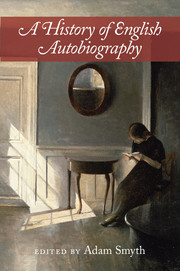Book contents
- Frontmatter
- Dedication
- Contents
- List of contributors
- 1 Introduction: The range, limits, and potentials of the form
- PART 1 AUTOBIOGRAPHY BEFORE ‘AUTOBIOGRAPHY’ (CA. 1300–1700)
- PART 2 RELIGION, GENDER, THINGS (CA. 1700–1800)
- PART 3 THE MANY NINETEENTH CENTURIES (CA. 1800–1900)
- PART 4 RELATIONAL LIVES AND FORMS OF REMEMBERING (CA. 1890–1930)
- PART 5 KINDS OF COMMUNITY (CA. 1930-CONTEMPORARY)
- 23 Poetry and autobiography in the 1930s: Auden, Isherwood, MacNeice, Spender
- 24 Documenting lives: Mass Observation, women's diaries, and everyday modernity
- 25 Postcolonial autobiography in English: The example of Trinidad
- 26 Around 2000: Memoir as literature
- 27 Illness narratives
- 28 Breaking the pact: Contemporary autobiographical diversions
- 29 The machines that write us: Social media and the evolution of the autobiographical impulse
- Index
- References
27 - Illness narratives
from PART 5 - KINDS OF COMMUNITY (CA. 1930-CONTEMPORARY)
Published online by Cambridge University Press: 05 March 2016
- Frontmatter
- Dedication
- Contents
- List of contributors
- 1 Introduction: The range, limits, and potentials of the form
- PART 1 AUTOBIOGRAPHY BEFORE ‘AUTOBIOGRAPHY’ (CA. 1300–1700)
- PART 2 RELIGION, GENDER, THINGS (CA. 1700–1800)
- PART 3 THE MANY NINETEENTH CENTURIES (CA. 1800–1900)
- PART 4 RELATIONAL LIVES AND FORMS OF REMEMBERING (CA. 1890–1930)
- PART 5 KINDS OF COMMUNITY (CA. 1930-CONTEMPORARY)
- 23 Poetry and autobiography in the 1930s: Auden, Isherwood, MacNeice, Spender
- 24 Documenting lives: Mass Observation, women's diaries, and everyday modernity
- 25 Postcolonial autobiography in English: The example of Trinidad
- 26 Around 2000: Memoir as literature
- 27 Illness narratives
- 28 Breaking the pact: Contemporary autobiographical diversions
- 29 The machines that write us: Social media and the evolution of the autobiographical impulse
- Index
- References
Summary
Illness narrative is a capacious category. It is comparable to life-writing in that it is defined as much as by what it doesn't exclude as by what it includes. Illness narratives can be fictional as well as non-fictional. They can be written by carers as well as patients. They can run to any length and can take the form of poetry and drama as well as prose. And, judging by present practice, any text in which illness plays a conspicuous part can count as an illness narrative. At the highbrow end of the spectrum, we find literary and philosophic memoirs such as Philip Roth's Patrimony: A True Story (1991), Gillian Rose's Love's Work (1995), and Joan Didion's The Year of Magical Thinking (2005) and Blue Nights (2011). One of the things that distinguishes literary memoirs of illness from other kinds is that they tend to range far into the surrounding life. At the lowbrow end are memoirs that would not disgrace the category of ‘misery lit’. Perhaps the most written-about specimen is James Frey's A Million Little Pieces, which was first published in 2003 as a memoir of the author's addiction to alcohol and crack cocaine. In September 2005, Oprah Winfrey selected it for her television show book club, and it then topped the New York Times bestseller list for fifteen weeks. It was subsequently revealed that crucial portions of the memoir were fabricated and it was reissued as a novel.
Illness narratives used to be comparatively rare. According to Anne Hunsaker Hawkins, book-length accounts of illness first became a distinct publishing phenomenon only in the 1950s and were extremely rare before 1900. The post-1950 sort were mostly self-help books, intended for patients recently diagnosed with the same condition as the author, and, as Hawkins observes, they usually ‘projected a positive attitude towards medicine’ (Hawkins 1999, 4). By the late 1970s, a new trend could be seen in which autobiographers criticised the dehumanising effects of modern healthcare. In the United States especially, this trend sometimes went hand in hand with advocacy of alternative therapies. Perhaps the most widely read memoir of this kind was Norman Cousins's Anatomy of an Illness (1979).
- Type
- Chapter
- Information
- A History of English Autobiography , pp. 388 - 401Publisher: Cambridge University PressPrint publication year: 2016
References
- 9
- Cited by



